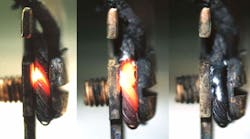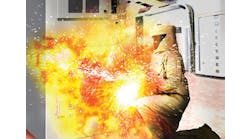My previous article, “Smoking Out the Main Causes of Electrical Fires,” featured in the November 2021 issue, explores why poor connections are the No. 1 cause of electrical fires in the United States. This is consistent with statistics from Ontario, Canada. Thus, it is important for electrical inspectors, fire investigators, and other personnel involved in fire safety issues to have a basic understanding of the phenomenon. Some of the common connection types available today include:
- Twist-on connectors (often referred to by the trade name WireNut).
- Screw connections.
- Spade or D-lug connectors.
While soldered or welded connections exist in some applications, most connection types depend on mechanical force for their integrity. This, in turn, requires sufficient force and good surface conditions at the interface. All metals exposed to air oxidize, but excessive oxidation can result in failure, as can dirt or other foreign substances.
Aluminum wiring problem
Old-timers will remember the aluminum wiring problem from the mid-1970s, which occurred in the United States and Canada. The problem was not with the wiring itself but with the connections.
Aluminum branch circuit wiring was introduced in that era as a cost-cutting measure. However, adequate engineering had not been done on the interface points at the connections in outlets, switches, and other devices. As it turned out, these connections were not properly engineered to cope with thermal cycling.
In most residential and light-commercial applications, there are few sustained loads; most loads are “on” only part of the time, resulting in thermal cycling of the circuit, including the connections. The problem was that the aluminum wires used had too high a yield strength and too poor a creep behavior. This meant that, with reasonable force applied, the wire failed to conform to mating parts well enough during initial installation, while later cycling progressively relaxed the force and progressively decreased the area available for conducting electricity through the interface. Note that this was a problem only for 12 AWG and 10 AWG branch-circuit connections. Aluminum feeders, service entrance cables, and other high-ampacity circuits can safely use aluminum wiring because the connections there are not subject to the same problems.
Copper and brass
Today, the bulk of fires due to poor connections involve copper or brass as the main metals, with smaller amounts of plated steel also being encountered. Thus, most commonly, we are not dealing with poor design engineering but with poor workmanship when failures occur. While poor workmanship can come in a variety of types, the most common fault is inadequate tightening. In a smaller fraction of the fires, environmental contamination can be the causative factor (e.g., salt-water splashing or salty air contamination).
Examples of poor connections
Most poor connections are due to sloppy workmanship. For example, an electrician in a hurry fails to properly torque a connection. Nevertheless, Photo 1 shows an example where bad design (not bad workmanship) led to overheating of some lamp connectors. These connectors were used for some low-voltage wiring with a load of 12.5A. This load is substantial, yet the design of the connectors required the electrician to use a miniature screwdriver, which cannot reasonably be expected to supply adequate torque to the recessed setscrew.
More common are failures of screw connections at duplex receptacles. Photo 2 shows a laboratory experiment exhibiting a progressive sequence of failure at such a connection. Poor connections often — but not necessarily — appear to be glowing, which can involve temperatures in excess of 2,192ºF (1,200ºC). Note that while copper itself melts at 1,981ºF (1,083ºC), its oxides can be heated to higher temperatures.
It’s important to appreciate that glowing may not be steady but may rather have an intermittent character. It is also important to understand that while reaching such high temperatures is of serious concern, not all glowing connections lead to a fire. Instead, a significant fraction will simply open up and no longer function. This is why finding “dead” outlets in a building should be a major concern to inspectors. The likely reason why an outlet died is that there was a bad connection that, after a certain amount of time, opened up. Left undisturbed, the connection is likely to stay dead. However, the concern is that the same individual who installed this receptacle wired other outlets in the same manner, and one of those could very well lead to fire rather than an open circuit.
Delving into the details, engineers might want to know the electrical characteristics of a poor connection. Although these can vary widely, some example test results are shown in the Figure below. The results show a power drop in the range of 5W to 50W, with a voltage drop of 3V to 25V. If the actual results are 12W and 7V, this does not constitute a significant voltage drop or a large power draw. Thus, the condition might not readily be detected in the functioning of the circuit unless it had a persistently intermittent character.
What advice can be given to investigators potentially encountering a fire starting from a poor connection? First, do not expect to find arc beads. Visible arcing artifacts can often be found after such an event, but there is no requirement for such artifacts to be created in all cases. Some investigators and forensic engineers are too narrowly focused and believe arc beads are the one-and-only evidence of an electrical failure. This practice needs to be strongly discouraged. Statistically, an arc bead is much more likely to be a victim of fire than its cause. Conversely, electrical fires can start without any arc beads being present.
In many cases, a bad connection can be recognized by looking at the local burn patterns. In the case of receptacles, for example, if the device is damaged due to an ongoing room fire, then when you remove it from the wall and look at the side of the device, you should see a burn damage gradient that is severe at the front and progressively milder further back. Conversely, if the receptacle was overheating due to a bad connection, there is likely to be a “bull’s eye” pattern visible centered over the suspect area (Photo 3).
Another technique that’s important in the investigation of artifacts is metallurgical analysis. High temperatures lead to grain growth in metals. Here, a comparative analysis is typically the best strategy. All artifacts in the vicinity of fire are likely to have been exposed to high temperatures, but temperatures can be expected to be hotter and longer at a bad connection than at a connection that had only undergone fire heating. Furthermore, in any receptacle, it is highly unlikely that all screw connections would have been overheating. Thus, if the connections are recovered, cross-sectioned, and analyzed, excessive grain growth may potentially be identified, allowing a particular connection to be suspected.
Dr. Vyto Babrauskas is a forensic science specialist working in the areas of fire and explosion safety. He recently published the handbook, “Electrical Fires and Explosions” in April 2021. He can be reached at [email protected].








